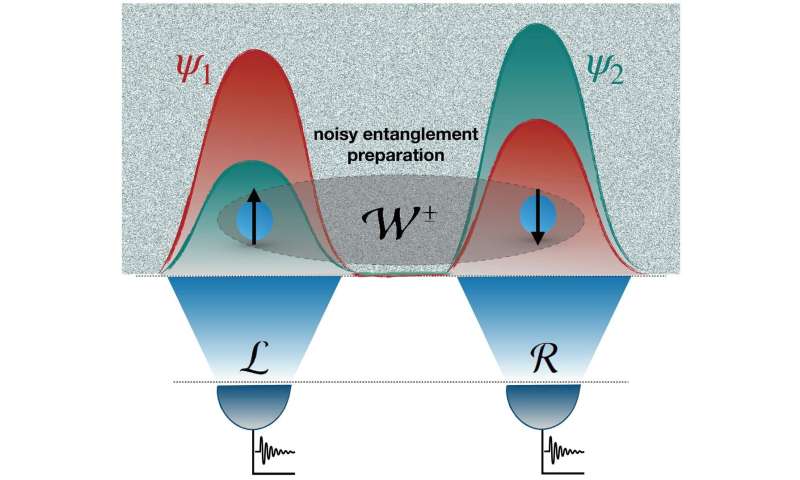Adjustable indistinguishability protects quantum entanglement preparation against noise

Theoretical physicists at the University of Palermo (Italy) have recently developed a study showing how controllable spatial indistinguishability of identical subsystems can be an inherent control of composite systems for generating noise-free entanglement. Published in 14 May online issue of npj Quantum Information, their results provide important insights toward the search for efficient strategies to shield quantum features from surrounding noise, a primary problem in emerging quantum technology. The research was coordinated by Rosario Lo Franco (Department of Engineering) with co-authors Farzam Nosrati, Ph.D. student at the Department of Engineering, and Alessia Castellini and Giuseppe Compagno at the Department of Physics and Chemistry.
Quantum information science is one of the most active research fields with high potential impact on society. Devices composed of quantum subsystems include such disruptive technologies as quantum communication and quantum computers. In principle, quantum computers would have much higher computing capacities than the most powerful supercomputers currently available, and could solve complex problems very quickly. This could greatly accelerate the design of drugs, the search for items in large databases or the analysis of astronomical data.
Quantum networks allow the transmission of secure and spy-proof information (quantum cryptography) through processes such as quantum teleportation. Furthermore, increasingly precise sensors and measuring instruments are possible thanks to quantum-enhanced methods. Quantum technologies usually base their operation on assemblies of quantum bits (qubits), each of which, unlike the classical bits of ordinary computers, can exist simultaneously in a quantum superposition as both zero and one.
The set of these qubits can be prepared in configurations that exhibit strong correlations that are not possible with ordinary devices. Such quantum correlations, typically known as entanglement, play a central role in implementing quantum information tasks. One of the main problems in the implementation of qubit systems is the detrimental influence of the environment in which the system is embedded, which tends to destroy entanglement and quantum resources in general at the preparation stage. Thus, the international scientific community is pursuing strategies for overcoming this problem. This is the subject addressed by the physicists from Palermo.
In quantum mechanics, particles have both a corpuscular and wave nature. They are described by a wave function that determines their physical properties (for example, electron spin or photon polarization) and establishes the probability with which a particle can be found in a region of space. Results obtained previously by Lo Franco and Compagno showed that: (i) identical particles (i.e. quantum elements of the same species, like photons, electrons, atoms generic qubits) prepared independently can get entangled when their wave functions overlap in space, even without interaction between the particles [see, Sci. Rep. 6, 20603 (2016), story]; (ii) the entanglement so obtained can be used as a resource for quantum information processes [see Phys. Rev. Lett. 120, 240403 (2018), story]. Bringing these ideas to the fore, Lo Franco and colleagues have now proved that in a system of identical qubits, whose spatial overlap of the respective wave functions can be adjusted, the established quantum entanglement can be efficiently shielded from destructive environmental effects. "Thanks to the approach to identical particles already developed by Lo Franco and Compagno, we have introduced a measure of spatial indistinguishability as a controllable resource of quantum information," says Nosrati, "which then allowed us to demonstrate the fundamental role of particle identity as a quantum property for producing entanglement protected from environmental disturbance". The key idea behind this result is that the noise action on a two-qubit entanglement can be suppressed by making identical qubits spatially overlapping. This way, in fact, the indistinguishability of the qubits prevents the appearance of some unwanted states due to the noise so that the preserved entanglement can be finally accessed and utilized by localized measurements performed on two separated operational sites (nodes of a quantum network). "It is remarkable that the spatial indistinguishability of the qubits does not need to be perfect", says Lo Franco, "and yet entanglement can be maintained to values which violate Bell inequality, so showing solid nonlocal traits". Experimental verification of these theoretical predictions is now in order in collaboration with external laboratories, employing photonic qubits as identical particles of the quantum network. "We are happy with the theoretical results obtained and with the experimental implementations in progress," continues Lo Franco, "especially in such a difficult time due to the COVID-19 outbreak. The scientific community works to try and overcome difficulties in such a way that research and international collaborations do not stop".
The title of the paper is "Robust entanglement preparation against noise by controlling spatial indistinguishability". It is available in the May 14th online issue of npj Quantum information.
More information:
Farzam Nosrati et al. Robust entanglement preparation against noise by controlling spatial indistinguishability, npj Quantum Information (2020). DOI: 10.1038/s41534-020-0271-7
Provided by The University of Palermo